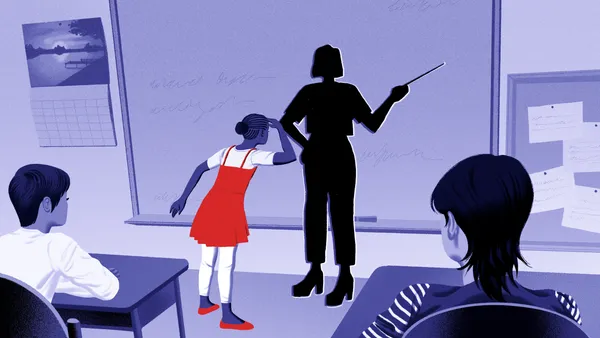Dive Brief:
- Between the 2020-21 and 2021-22 school years, 84.1% of public school teachers stayed at the same school while 7.9% left the profession and 7.9% changed schools, according to a survey released in December by the National Center for Education Statistics.
- The data shows teachers' decisions to stay, change schools or quit the profession varied slightly in schools with different poverty levels. At schools with less than 35% of students approved for free or reduced-price lunch, 85% of teachers stayed, 7% moved schools and 8% left teaching, NCES found. For schools where three-quarters or more of students qualified for free or reduced-price meals, 82% of teachers stayed, 9% changed schools and 9% left.
- Among those leaving the teaching profession, retirement was the most cited reason (16%), followed by health issues or child care needs (15%). Additionally, 13% said they left to pursue a new field and 9% because they wanted or needed a higher salary.
Dive Insight:
NCES data indicates that only a slightly lower percentage of teachers are staying at the same school while a slightly higher portion are leaving the profession altogether compared to data from more than three decades ago.
In the 1988-89 school year, 86.5% of teachers stayed at their school from the previous year while 5.6% stopped teaching — meaning year-over-year levels decreased by just 2.4 percentage points and increased by 2.3 percentage points, respectively, between 1988-89 and 2021-22. Despite the slight decline in teacher retention over the past several decades, attrition rates remained relatively steady in the last 13 years. In 2008-09, 84.5% of teachers stayed at their schools and 8% left the profession.
While education workforce experts are still evaluating the scope of teacher shortages nationwide, the new NCES data gives a peek into the pandemic's impact on teacher attrition.
The NCES data further shows that teacher attrition is not a new issue.
Anecdotal evidence from school leaders as well as other research has suggested the pandemic would exacerbate staffing shortages, particularly for educators given the mounting stress put on them. That could still be the case.
A separate NCES survey from October found that 86% of public schools said they faced difficulties hiring teachers going into the 2023-24 school year. Still, fewer schools this year reported feeling understaffed compared to the start of 2022-23 — 45% versus 53%.
Estimated teacher vacancies jumped 51% between August 2022 and August 2023, but are likely to plateau moving forward, according to researchers from universities including Kansas State University and the University of Pittsburgh.
While research continues to find mixed results on how widespread teacher shortages really are, district and state leaders continue searching for innovative solutions to the problem. Those include developing registered teacher apprenticeship programs, reducing barriers for teaching licensures and hiring virtual live instructors.










